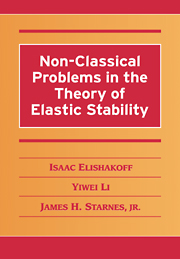Book contents
- Frontmatter
- Contents
- Preface: Why Still Another Book on Stability?
- 1 Mode Localization in Buckling of Structures
- 2 Deterministic Problems of Shells with Variable Thickness
- 3 Stochastic Buckling of Structures: Monte Carlo Method
- 4 Stochastic Buckling of Structures: Analytical and Numerical Non-Monte Carlo Techniques
- 5 Anti-Optimization in Buckling of Structures
- 6 Application of the Godunov-Conte Shooting Method to Buckling Analysis
- 7 Application of Computerized Symbolic Algebra in Buckling Analysis
- Bibliography
- Author Index
- Subject Index
2 - Deterministic Problems of Shells with Variable Thickness
Published online by Cambridge University Press: 06 January 2010
- Frontmatter
- Contents
- Preface: Why Still Another Book on Stability?
- 1 Mode Localization in Buckling of Structures
- 2 Deterministic Problems of Shells with Variable Thickness
- 3 Stochastic Buckling of Structures: Monte Carlo Method
- 4 Stochastic Buckling of Structures: Analytical and Numerical Non-Monte Carlo Techniques
- 5 Anti-Optimization in Buckling of Structures
- 6 Application of the Godunov-Conte Shooting Method to Buckling Analysis
- 7 Application of Computerized Symbolic Algebra in Buckling Analysis
- Bibliography
- Author Index
- Subject Index
Summary
Shells were first used by the Creator of the earth and its inhabitants. The list of natural shell-like structures is long, and the strength properties of some of them are remarkable. Egg shells range in size from those of the smallest insects to the large ostrich eggs, and cellular structures are the building blocks for both plants and animals. Bamboo is basically a thin-walled cylindrical structure, as is the root section of a bird's feather. The latter structural element develops remarkable load-carrying abilities.
E. E. SechlerThe degeneration of a bifurcation point into a limit point due to presence of imperfections … suggests that bifurcation is an exception rather than the rule. In spite of this the literature on elastic stability and buckling of structures deals preponderantly with bifurcation buckling problems. Human frailty is, perhaps, the main reason for this state of affairs.
W. T. KoiterThis chapter focuses on the buckling of cylindrical shells with small thickness variations. Two important cases of thickness variation pattern are considered. Asymptotic formulas up to the second order of the thickness variation parameter Є are derived by combining the perturbation and weighted residual methods. The expressions obtained in this study reduce to Koiter's formulas, when only the first-order term of the thickness variation parameter is retained in the analysis. Results from the asymptotic formula are compared with the those obtained through the purely numerical techniques of the finite difference method and the shooting method.
- Type
- Chapter
- Information
- Non-Classical Problems in the Theory of Elastic Stability , pp. 43 - 106Publisher: Cambridge University PressPrint publication year: 2001
- 1
- Cited by



